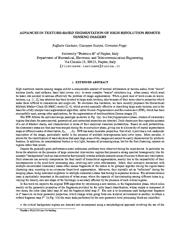Advances in texture-based segmentation of high resolution remote sensing imagery
Raffaele Gaetano, Giuseppe Scarpa, Giovanni Poggi
2009
2009 IEEE International Geoscience and Remote Sensing Symposium
EXTENDED ABSTRACT High resolution remote sensing images exhibit a considerable amount of textural information at various scales, from "micro" textures (roofs, road surfaces, basic land covers, etc.) to more complex "macro" structures (e.g. urban areas), which must be taken into account to address effectively the problem of image segmentation. While a good deal of work exists on microtextures, e.g. [1, 2] , less attention has been devoted to large-scale textures, also because of their more
more »
... e properties which make them difficult to characterize and single out. To overcome this limitation, we have recently proposed the Hierarchical Multiple Markov Chain (H-MMC) model [3, 4] , which proved especially effective in describing large-scale textures, and is the basis for a fully unsupervised segmentation algorithm, called Texture Fragmentation and Reconstruction (TFR), which has been successfully used, among other applications, for the segmentation of multiresolution Ikonos images [5] . The TFR follows the split-and-merge paradigm as shown in Fig. 1(a) . In a first fragmentation phase, clusters of elementary regions that share the same spectral, geometrical, and contextual properties are detected. Such clusters are then regarded as states of a set of Markov chains, and characterized in terms of their empirical transition probabilities. Based on such probabilities, the elementary states are then pairwise merged during the recostruction phase, giving rise to a hierarchy of nested segmentation maps at different scales of observation, S 2 , . . . , S N . TFR has many desirable properties: first of all, it provides a rich multiscale description of the image, particularly useful in the presence of multiple heterogeneous land cover types. More peculiar, it allows for the identification of macrotextures that span large areas of the images and cannot be easily characterized by synthetic features. In addition, its computational burden is very light, because all processing steps, but for the first clustering, operate on regions rather than pixels. Despite the generally good performance some unforeseen problems were observed during the experiments. In particular we focus the attention on the presence of large connected inter-texture regions that present a strong spectral homogeneity, like for example "backgrounds" such as road networks that typically invades multiple semantic areas of a scene without any interruption. Such elements can severely compromise the final result of hierarchical segmentation, mainly due to the impossibility of their decomposition in the pixel-level processing step, involving only color informations. Infact, their extensive interaction with multiple uncorrelated elementary states often causes fragments of the latters to be grouped together during the region-based clustering step, resorting to an erroneous finest-level segmentation. Moreover, they typically act as "collectors" during the merging phase, being dominant neighbour to multiple elementary states that belong to separated textures. The aforementioned issue is particularly important in the analysis of urban areas, where the capacity of discriminating among different types (e.g. varying for density, size and shape of the buildings) is seriously affected by the presence of such critical regions. In this work we improve the original TFR algorithm by introducing a new module, in the fragmentation phase, which relies mainly on the geometric properties of the fragments provided by the color based classification, whose output is composed of two items, the color class label map M and the fragment label map F . The aim is to decompose each background fragment in F based on its local geometric properties, which change when going from one textured environment to another, to obtain a refined fragment map F . In Fig. 1(b) the main tasks performed by the new geometric level processing block are identified: • the critical background regions are detected and decomposed using a morphological approach involving the use of the Thanks to FALCO Project for funding. Fragment. Reconstr. Color Based Classification Spatial Based Clustering Merging S2 S3 SN−1 SN M F Background Detection and Decomposition RAG Denoising and Linear Structure Rec. Background Reconstruction
doi:10.1109/igarss.2009.5417361
dblp:conf/igarss/GaetanoSP09a
fatcat:3ju6xt5cmrh2rf4zw2pmyeleae

